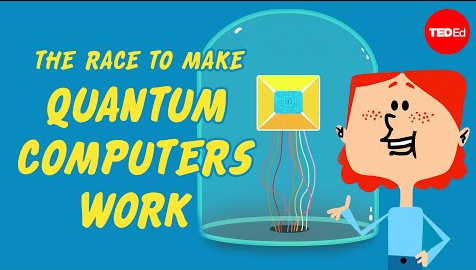The contents of this metal cylinder could either revolutionize technology or be completely useless
这个金属桶里的东西可能会带来技术的革命,也可能完全没用,
it all depends on whether we can harness the strange physics of matter at very, very small scales.
这要看我们能不能在极其小的尺度上控制物质的特性。
To have even a chance of doing so, we have to control the environment precisely:
这么做的最基本前提是精准地控制实验环境:
the thick tabletop and legs guard against vibrations from footsteps, nearby elevators, and opening or closing doors.
用厚实的桌面和桌腿来对抗振动,来自脚步、附近电梯和开门关门的振动。
The cylinder is a vacuum chamber, devoid of all the gases in air.
这个桶是真空腔体,没有任何空气成分。
Inside the vacuum chamber is a smaller, extremely cold compartment, reachable by tiny laser beams.
真空腔体内是一个更小的腔室,它温度极低,可以用微小激光束操作。
Inside are ultra-sensitive particles that make up a quantum computer.
小腔室里面是超敏感的粒子,用这些粒子能做出量子计算机。
So what makes these particles worth the effort?
为什么费力折腾这些粒子?
In theory, quantum computers could outstrip the computational limits of classical computers.
理论上说,量子计算机能够突破传统计算机的计算能力上限。
Classical computers process data in the form of bits.
传统计算机用比特来处理数据。
Each bit can switch between two states labeled zero and one.
每个比特在0和1两个状态之间切换。
A quantum computer uses something called a qubit, which can switch between zero, one, and what's called a superposition.
而量子计算机用的是量子比特,它的状态包括0、1以及叠加态。
While the qubit is in its superposition, it has a lot more information than one or zero.
量子比特处于叠加态时,它的信息量远比0或1都多。
You can think of these positions as points on a sphere: the north and south poles of the sphere represent one and zero.
可以把这些量子位想象成球体上的位置:北极和南极代表1和0。
A bit can only switch between these two poles, but when a qubit is in its superposition, it can be at any point on the sphere.
比特只能在这两极之间切换,但当量子比特处于叠加态时,它可能处于球体上的任何位置。
We can't locate it exactly -- the moment we read it, the qubit resolves into a zero or a one.
我们还不能确定它的精确位置--在我们去读它时,量子比特已经回到了0或1。
But even though we can't observe the qubit in its superposition, we can manipulate it to perform particular operations while in this state.
但是,即使不能观察叠加态的量子比特,我们还是能操纵量子比特,让它在处于叠加态时执行特定的运算。
So as a problem grows more complicated, a classical computer needs correspondingly more bits to solve it,
随着要解决的问题越来越复杂,传统计算机需要更多比特来解题,
while a quantum computer will theoretically be able to handle more and more complicated problems
而量子计算机在理论上可以处理更复杂的问题,
without requiring as many more qubits as a classical computer would need bits.
而不需要像传统计算机那样增加更多量子比特。
The unique properties of quantum computers result from the behavior of atomic and subatomic particles.
量子计算机的独特性质来自于原子和次原子粒子的性质。
These particles have quantum states, which correspond to the state of the qubit.
这些粒子具有量子态,量子态就是量子比特的状态。
Quantum states are incredibly fragile, easily destroyed by temperature and pressure fluctuations,
量子态极度脆弱,温度和压力波动都能轻易消灭量子态,
stray electromagnetic fields, and collisions with nearby particles.
还有杂散电磁场,以及与附近粒子相撞。
That's why quantum computers need such an elaborate set up.
因此,量子计算机需要非常精密的环境设置。

It's also why, for now, the power of quantum computers remains largely theoretical.
这也是为什么迄今为止,量子计算机仍在很大程度上处于理论阶段。
So far, we can only control a few qubits in the same place at the same time.
目前,我们只能在同一时间地点控制几个量子比特。
There are two key components involved in managing these fickle quantum states effectively:
要有效管理瞬息万变的量子态,涉及两个关键因素:
the types of particles a quantum computer uses, and how it manipulates those particles.
量子计算机使用的粒子类型,和量子计算机操作这些粒子的方式。
For now, there are two leading approaches: trapped ions and superconducting qubits.
目前,有两种主流方法:离子阱和超导量子比特。
A trapped ion quantum computer uses ions as its particles and manipulates them with lasers.
离子阱量子计算机把离子用作所需粒子,用激光操纵离子。
The ions are housed in a trap made of electrical fields.
离子容纳在电场形成的陷阱中。
Inputs from the lasers tell the ions what operation to make by causing the qubit state to rotate on the sphere.
输入的激光让量子比特态在球体上转动,以此来告诉离子该做什么工作。
To use a simplified example, the lasers could input the question: what are the prime factors of 15?
举个简单的例子,激光可以输入一个问题:15的素因子是多少?
In response, the ions may release photons -- the state of the qubit determines whether the ion emits photons and how many photons it emits.
离子在回答问题时会释放光量子--量子比特的状态决定了离子是否释放光量子,以及发射多少个光量子。
An imaging system collects these photons and processes them to reveal the answer: 3 and 5.
成像系统收集这些光量子,加以处理而得出答案:3和5。
Superconducting qubit quantum computers do the same thing in a different way: using a chip with electrical circuits instead of an ion trap.
超导量子比特量子计算机做的是同样一件事,但方法不同:它使用有电路的芯片,而不是量子阱。
The states of each electrical circuit translate to the state of the qubit.
每个电路的状态都对应着量子比特态。
They can be manipulated with electrical inputs in the form of microwaves.
可以用微波形式的电输入来操控。
So: the qubits come from either ions or electrical circuits, acted on by either lasers or microwaves.
因此,量子比特来自离子或电路,用激光或者微波来操纵。
Each approach has advantages and disadvantages.
两个方法各有优缺点。
Ions can be manipulated very precisely, and they last a long time,
离子可以非常精确地控制,并且离子寿命长,
but as more ions are added to a trap, it becomes increasingly difficult to control each with precision.
但随着陷阱里离子越来越多,精确控制每个离子就越来越难。
We can't currently contain enough ions in a trap to make advanced computations,
目前我们还不能在一个陷阱里容纳足够的量子来做先进的计算,
but one possible solution might be to connect many smaller traps that communicate with each other via photons rather than trying to create one big trap.
但一种办法是把很多较小的陷阱连起来,这些陷阱通过光量子互相通信,这样就不用费力做一个巨大的陷阱了。
Superconducting circuits, meanwhile, make operations much faster than trapped ions,
同时,超导电路的计算速度比离子阱快很多,
and it's easier to scale up the number of circuits in a computer than the number of ions.
计算机中的电路数量也更容易扩增,比增加离子阱中的离子容易。
But the circuits are also more fragile, and have a shorter overall lifespan.
但电路也比较脆弱,总寿命要短一些。
And as quantum computers advance, they will still be subject to the environmental constraints needed to preserve quantum states.
并且随着量子计算机的发展,保存量子态所需的环境也会受到限制。
But in spite of all these obstacles, we've already succeeded at making computations in a realm we can't enter or even observe.
但是,尽管困难重重,我们已经在一个进不去也看不到的世界成功实现了计算。












